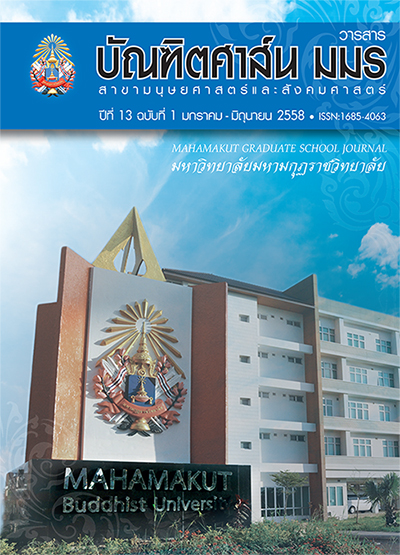ศึกษาการเจริญวิปัสสนาภาวนาเพื่อการกำจัดกามราคะ ในคัมภีร์พุทธศาสนาเถรวาท
บทคัดย่อ
วิทยานิพนธ์ฉบับนี้ มีวัตถุประสงค์ ดังนี้ 1) เพื่อ ศึกษากามราคะที่ปรากฏในคัมภีร์พระพุทธศาสนา เถรวาท 2) เพื่อศึกษาหลักการเจริญวิปัสสนาตาม หลักมหาสติปัฏฐานสูตร 3) เพื่อศึกษาการเจริญ วิปัสสนาภาวนาเพื่อการกำจัดกามราคะ โดยศึกษา ข้อมูลจากพระไตรปิฎก อรรถกถา ฎีกา คัมภีร์ ปกรณวิเสส วิสุทธิมรรค เอกสารทางวิชาการ และ ตำราอื่นๆ ที่เกี่ยวข้อง ผลการวิจัยพบว่า
คำว่า “กามราคะ” แบ่งออกเป็น 2 คำ คือ กาม กับ ราคะ คำว่า กาม แปลว่า ความอยาก ความ ต้องการ ความปรารถนาความใคร่ ส่วนความหมาย ของราคะ หมายถึง ความกำหนัด ความยินดีในกาม ความติดใจในอารมณ์ รวมความว่า สภาพที่มีความ พอใจในกิเลสกาม และวัตถุกามชื่อว่ากามราคะ สาเหตุการเกิดกามราคะเพราะอาศัยปัจจัยภายนอก และปัจจัยภายใน ปัจจัยภายนอก ได้แก่ วัตถุกาม และสุภนิมิต ส่วนปัจจัยภายใน ได้แก่ กิเลสกาม และอโยนิโสมนสิการ กามราคะเมื่อเกิดขึ้นในจิตใจ จิตจะซัดส่ายไปมา และทำจิตให้เหี่ยวแห้ง คือ ถูก ราคะบีบ คั้นแล้วก็จะแสดงออกมาทางด้านกายภาพ เพื่อให้ตอบสนองความต้องการในรูป เสียง กลิ่น รส และโผฏฐัพพะ เนื่องจากมีความยินดี ความเพ่งเล็ง มี จิตปฏิพัทธ์ในรูป เสียง กลิ่น รส และผัสสะ ไฟแห่ง ราคะนี้จะเผาลนหมู่สัตว์ผู้ตกอยู่ในอำนาจตลอดทั้ง ภพนี้ และภพหน้าจนกว่าจะได้บรรลุปริญญากิจ และ ปริหานกิจ
การเจริญวิปัสสนาตามหลักมหาสติปัฏฐาน สูตรมีเป้าหมายสำคัญ คือ การตั้งสติสัมปชัญญะ เพื่อเพียรพิจารณากาย เวทนา จิต และธรรม เพื่อ การกำจัดอภิชฌา และโทมนัสในโลกให้ได้ โดยแยก พิจารณาเป็น 4 ประการ คือ กายานุปัสสนาสติปัฎ ฐาน เวทนานุปัสสนาสติปัฎฐาน จิตตานุปัสสนาสติ ปัฎฐาน ธัมมานุปัสสนาสติปัฎฐาน
การเจริญวิปัสสนาภาวนาเพื่อการกำจัดกาม ราคะ คือ การเจริญจิตตานุปัสสนาสติปัฏฐาน เพื่อ การกำหนดรู้ราคะ สมดังที่พระพุทธองค์ตรัสไว้ใน มหาสติปฎั ฐานสูตรวา่ จิตมีราคะก็รูว้ า่ จิตมีราคะ โดย การกำหนดรูป เสียง กลิ่น รส สัมผัส และธรรมารมณ์ ผ่านการรับรู้ทางทวาร 6 โดยไม่มีการปรุงแต่งใดๆ ทั้งสิ้น การมีสติตามรู้จิตดังกล่าวมานี้ ย่อมส่งผลให้ ผู้ปฏิบัติ เห็นการเกิดดับของจิตได้ ผู้เห็นความเกิด ดับของจิตอย่างนี้ ย่อมจะเกิดสติระลึกรู้ มีเพียงจิต ที่รับรู้อารมณ์ไม่มี บุคคล เรา เขา บุรุษ สตรี ย่อม ปราศจากความยึดมั่นถือมั่นในโลก คือ อุปาทานขันธ์
เอกสารอ้างอิง
มหาจุฬาลงกรณราชวิทยาลัย. พระไตรปิฎกภาษาไทย ฉบับมหาจุฬาลงกรณราชวิทยาลัย. กรุงเทพมหานคร: โรง พิมพ์มหาจุฬาลงกรณราชวิทยาลัย, 2539.
มหามกุฏราชวิทยาลัย. พระไตรปิฎกพร้อมอรรถกถา แปล ชุด 91 เล่ม. กรุงเทพมหานคร: โรงพิมพ์มหามกุฏราช วิทยาลัย, 2534.
ข้อมูลปฐมภูมิ
พระพุทธโฆสเถร รจณา. สมเด็จพระพุฒาจารย์ (อาจ อาสภมหาเถร) แปลและเรียบเรียง. คัมภีร์วิสุทธิมรรค. พิมพ์ครั้ง ที่ 10. กรุงเทพมหานคร: บริษัทธนาเพรส จํากัด, 2554.
พระพุทธโฆสเถระ. คัมภีร์วิสุทธิมรรค. พิมพ์ครั้งที่ 10. กรุงเทพมหานคร: บริษัทธนาเพรส จํากัด, 2554.
พระอุปติสสเถระ. วิมุตติมรรค. พระเมธีธรรมาภรณ์ (ประยูร ธมฺมจิตฺโต) และคณะ แปลและเรียบเรียง. พิมพ์ครั้งที่ 2. กรุงเทพมหานคร: สํานักพิมพ์ศยาม บริษัทเคล็ดไทย จํากัด, 2538.
พระโสภณมหาเถระ (มหาสีสยาดอ). วิปัสสนานัย เล่ม 1. แปลและเรียบเรียงโดยพระคันธสาราภิวงศ์. กรุงเทพมหานคร: ห้างหุ่นส่วนจํากัด ประยูรสาสน์ไทยการพิมพ์, 2548.
_______. วิปัสสนานัย เล่ม 2. พระคันธสาราภิวงศ์ แปลและเรียบเรียง. กรุงเทพมหานคร: ห้าง หุ้นส่วนจํากัด ประยูร สาสน์ไทย การพิมพ์, 2555.
ดาวน์โหลด
เผยแพร่แล้ว
รูปแบบการอ้างอิง
ฉบับ
ประเภทบทความ
สัญญาอนุญาต
บทความวิชาการและบทความวิจัยในวารสารฉบับนี้ถือเป็นความรับผิดชอบของผู้เขียนเท่านั้น บทความที่ได้รับการตีพิมพ์ในวารสารบัณฑิตศาส์น ถือเป็นลิขสิทธิ์ของมหาวิทยาลัยมหามกุฏราชวิทยาลัย ตามพระราชบัญญัติลิขสิทธิ์



